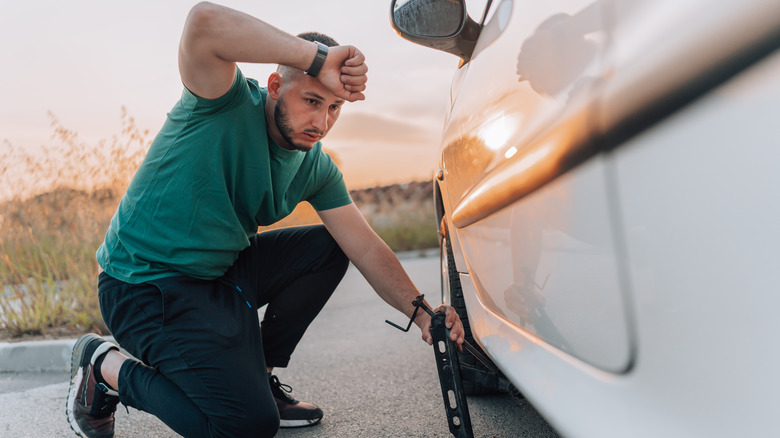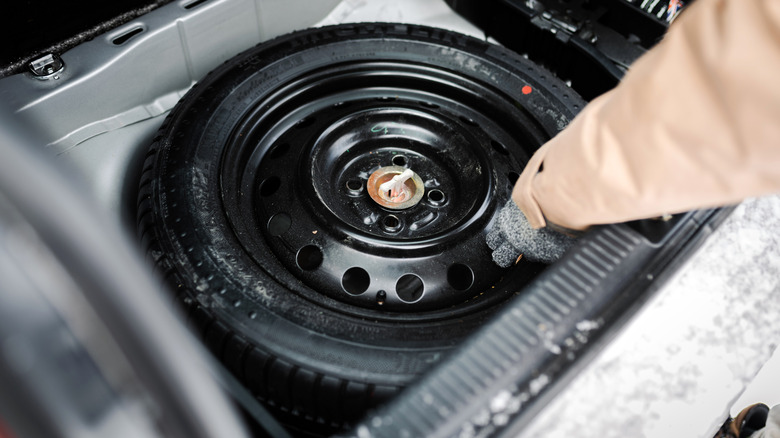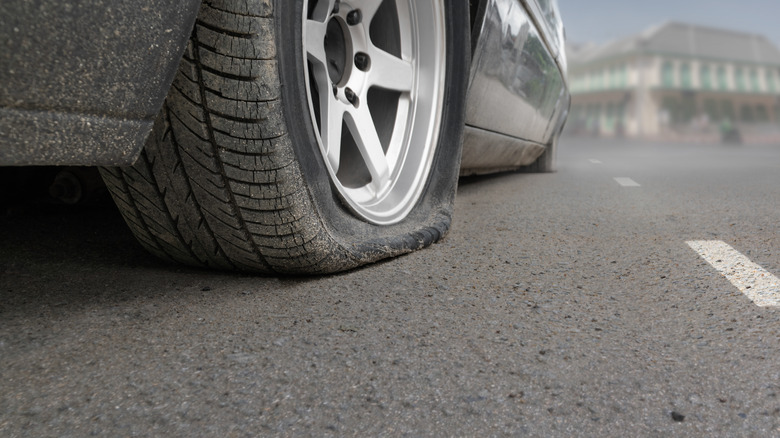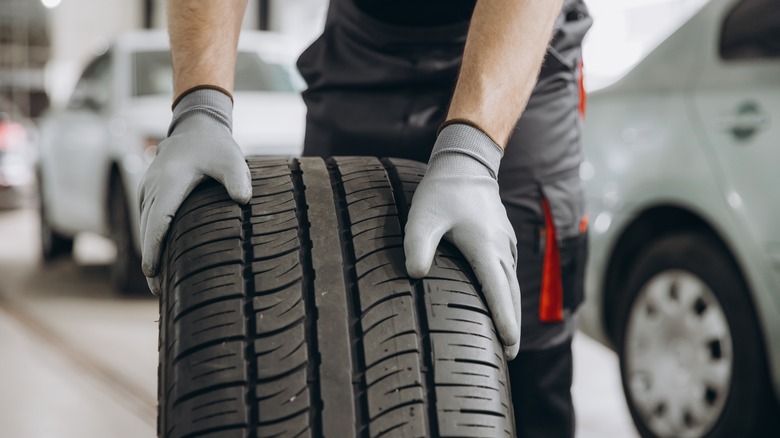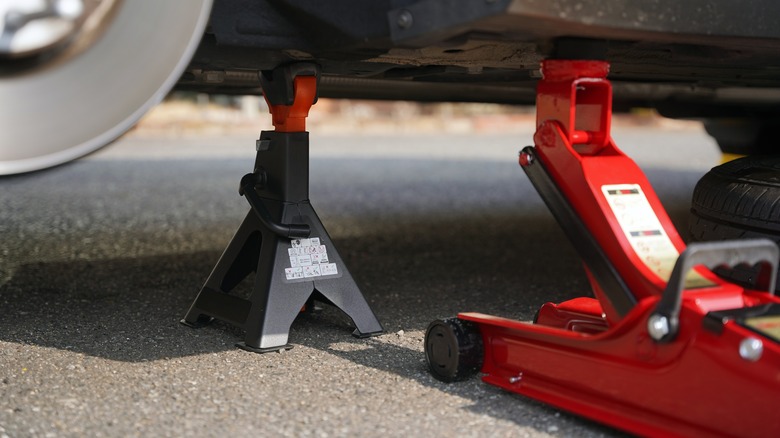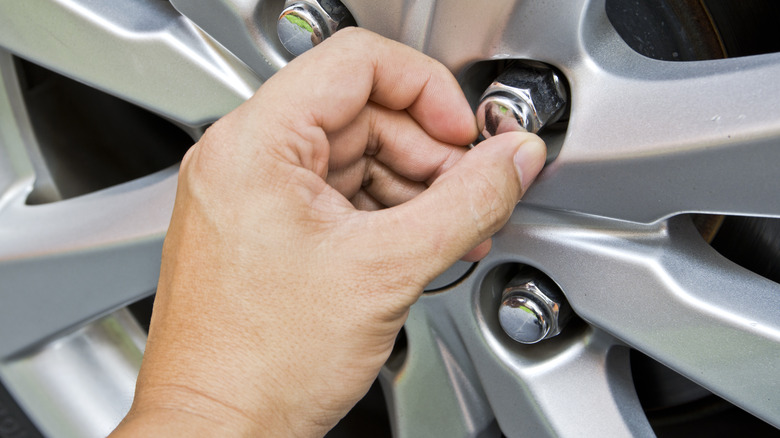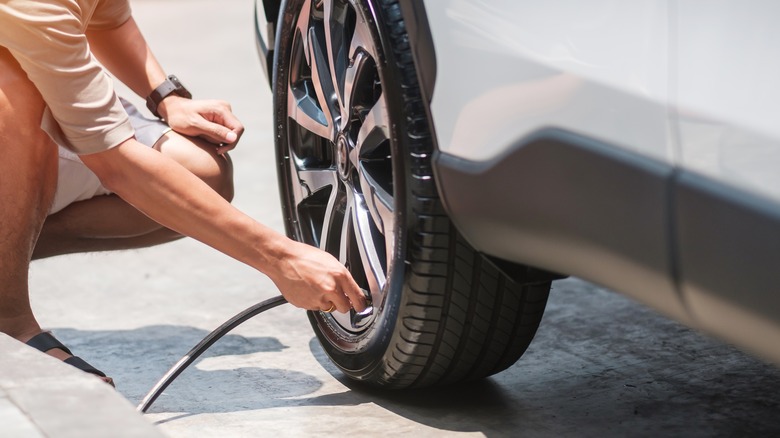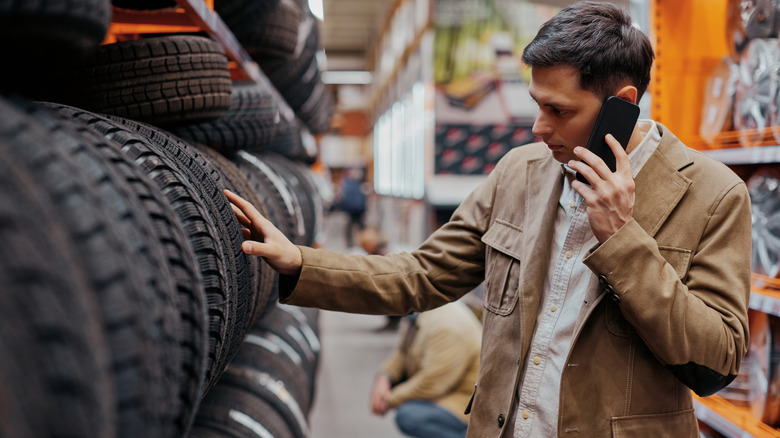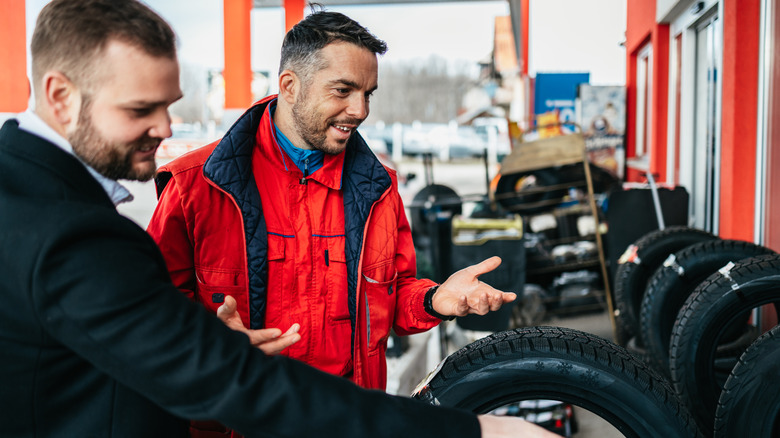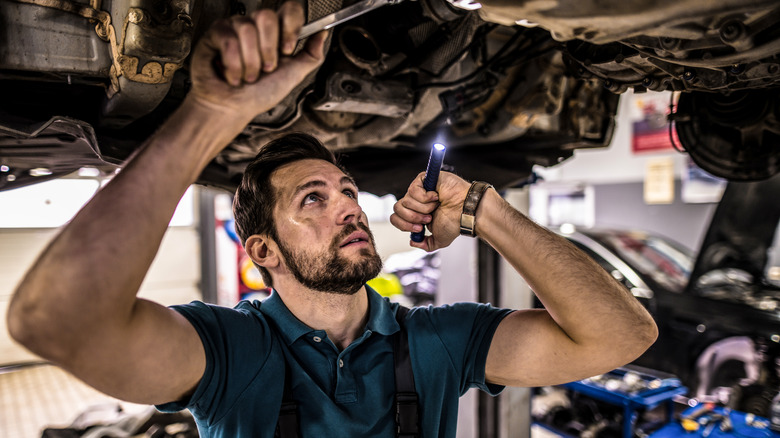10 Mistakes You Might Be Making When Changing The Tires On Your Vehicle
It seems like many people these days have forgotten the lost art of changing a car tire on their own. It seems easy enough to contact a tow truck or call AAA to have someone do it for you. However, there's a lot to gain by harnessing this skill yourself. Whether you have to swap out for a new tire due to a flat or just want to put on a new set of tires yourself to save money, it can really come in handy, provided you know what you're doing.
Even if you have all the items you need in your car to fix a flat tire, they won't do you much good if you wind up making a grave error. One seemingly small mistake could result in even greater damage to your vehicle. Even if you don't break anything, there's still the matter of making things more difficult on yourself than they need to be. Getting a flat tire is stressful enough as is — you don't need to compound that stress by doing something you think you heard your dad tell you to do that one time.
There's also a chance you don't have a flat, but it's merely time to swap out your old tires due to the tread getting a little shallow. You should always replace these worn-out tires in pairs while heeding these tips for an overall simpler experience.
Not having a spare
A great car feature that's seemingly disappeared over the last few decades is a full-size spare tire. Back in the day, cars would come with a fifth tire that was the same size as all of the others, so you could continue your trip exactly as you planned. Over time, this was taken out in favor of a smaller spare tire that could only handle slower speeds. It pretty much solely existed to get you to an auto shop, but these days, many cars are designed without any kind of spare.
Roughly 30 percent of new cars sold don't have any spare at all. This is done for various reasons, such as reducing the overall weight of the vehicle to enhance fuel economy. Better mileage is one thing, but if you find yourself on the side of the freeway without a spare, you'll wish you had gotten a car with some extra space to fit an additional tire. When going to purchase a new car, it may be worth it to you to consider whether there's a spare or if you'd be fine calling someone to tow you to a shop.
In the event there's no room for a spare, it's advised to have a puncture repair kit handy. These kits can fix minor damage to the point where you can at least drive a few miles to an auto shop. They won't do much good for more extensive damage or a hole directly in the sidewall. In either case, it'd be good to have a Plan B handy and know who to call because getting a flat tire is generally a matter of when — not if.
Working before securing a safe space
Many people are aware of the headache that immediately ensues when you're driving and begin hearing the "thwump, thwump, thwump" sound of a flat tire. When that happens, it's paramount to keep a cool head and not immediately panic. Your car should be just fine as you gradually and safely get off the road so that you can stop your vehicle and change the tire. However, it'll be in your best interest not to simply change it out on a freeway's shoulder, especially if the flat tire in question is closest to oncoming traffic.
It's not worth putting your own safety and well-being in jeopardy to try to change a tire. If you're able to, it'd be ideal to get off the freeway entirely. A parking lot is an ideal location, but there's always a chance that's not possible depending on your location. Regardless, you want to get away from speeding cars to the best of your ability. In the event you have to park on the side of a street or a median, try to do so on an straight stretch of road. Parking alongside a curve puts you at risk of another car not seeing you until it's too late.
Unfortunately, you don't decide where you get a flat. Driving for an extended period of time could damage your rim, which is an extra expense. However, if you don't feel comfortable getting out of your car, don't feel bad about calling a service to tow you somewhere else.
Replacing tire on an incline
Getting your vehicle away from oncoming traffic isn't the only consideration to make when looking for a good place to change a tire. You also want to avoid performing this task on any kind of slope. Again, this comes down to a safety concern, as an incline presents a risk of the car falling off the jack. You could further damage the car or seriously injure yourself if something isn't where it should be.
Anyone who finds themselves on a hill with a flat tire may want to consider filling up the tire just enough to drive it on a leveled area so that they don't damage the rim. Another good tip is to place wedges behind the tires (or in front depending on whether the slope's going uphill or downhill). Make sure the car is in park for an automatic or first/reverse for a manual when working on it to reduce the chances of the car rolling while you're trying to fix something. However, you should only rely on chocks when the slope has an angle of 10 degrees or less. If it's any steeper than that, the car could very well just roll right over the chock.
In general, your best bet is to simply avoid inclines completely when swapping tires. This is also important to remember even if you're just doing car work in your own driveway if there's any kind of incline to it.
Replacing it with the wrong kind of tire
There's really no excuse for putting the wrong size tire on your vehicle. You can see exactly what type of tire you need within your owner's manual, but if you've misplaced that, you should be able to find that information printed on a sticker located inside the driver's side door. A professional mechanic will know precisely where to look, but anyone who buys their own tires to put on themselves will need to do a little research to ensure nothing goes wrong.
It may not seem like a big deal to have one tire that's a little smaller or bigger, but this could have significant repercussions on your vehicle's performance. All of the other tires may need to work harder to compensate and give out to wear and tear sooner than expected. Plus, a tire that's bigger than it should be could come into contact with other components underneath your vehicle, damaging those in the process.
Knowing the exact size is just one of many expert tips to bear in mind when buying new car tires. You also want to consider what type of weather conditions you'll typically be dealing with so that your tires have the proper tread depth. Tires may not be the flashiest component of a car to replace, but they're arguably one of the most important.
Using an incorrect jack point
If you want to be ready replace a flat, you should consider keeping a floor jack and jack stand in your vehicle. The floor jack lifts your vehicle into the car so that you can perform any number of tasks underneath it, and the jack stand offers greater support to ensure the vehicle doesn't roll off. However, with both of these devices you need to make sure you're not just lifting your car from any old spot.
All cars have certain jacking points where you can lift it into the air without damaging the body or putting it at risk of rolling off. These points will differ from one vehicle to the next, so you should consult with your owner's manual to see where these points are with your specific model. For example, coupes and sedans typically have these points located in front of the rear tires but behind the front ones. For larger trucks, the locations are more likely to be around the rear and front axles. These points will likely have visually apparent reinforcement to support the car while in the air, but the manual should contain diagrams so that you don't make any errors.
Finally, it should go without saying that you don't want to purchase a cheap jack stand because it could be a disaster waiting to happen. Make sure your jack stand can support the full weight of your vehicle. If the stand can only handle 4,000 pounds, you don't want to put a car on it any heavier than that.
Failing to tighten the lug nuts correctly
Before you can replace the tire, you need to remove the lug nuts holding it in place. This can prove to be a bit of a challenge, as they can be on there pretty tightly, but a lug wrench should be able to get the job done. Once your new tire is on, it's critical to remember to put those lug nuts back on, and you want to ensure they're on there tightly.
First, you want to tighten them as much as you can by hand. Once you're ready to bust out the torque wrench, you need to ensure you go in the proper order. The tightening of the lug nuts should go in a star-shaped pattern, where you start at the top and then go to the bottom right and so on and so forth. It's the same order you would go in as though you were drawing a standard star by hand. This helps to make sure the mounting surface maintains even loading. Every lug nut should be at the same torque level or else you run the risk of the tire being loose and potentially falling off.
This should all be done while the vehicle is still on the jack stand. After you've made sure everything is torqued as it should be, you're ready to set it down.
Not checking if tires are inflated
There are easy ways to figure out what your car's tire pressure should be. That information should be readily available through your owner's manual or that sticker in the driver's side door that also mentions what size tires you should have. Most vehicles fall into the range of needing a tire pressure between 30 and 35 psi, and when you get a new tire installed, you want to make sure it's where it needs to be.
As you drive on your new tire, you may notice the TPMS light on your dashboard illuminate. This should only be temporary as your vehicle adjusts to the new tire, and ideally, it'll shut off on its own. However, it's a good idea to play it safe and make sure all your tires are where they need to be. Even if the tire is brand new, you want to make sure its pressure isn't too low nor too high. Going above the recommended psi can cause problems, too, so don't just assume more is better.
While you're at it, check the pressure for your other tires at this time, especially if you had to replace one due to it becoming flat. You may have driven over some debris, so you want to find any small punctures or leaks now before you're find yourself in a more precarious scenario.
Buying cheap or poor quality tires
The average cost of a new car tire varies depending on the size and brand, but a decent rule of thumb is to expect to spend anywhere between $100 and $250 per tire. Granted, it could be a lot more, especially if you drive a huge truck that requires massive tires. It's natural that people don't want to spend more on a tire than they should, but you don't want to go in the opposite direction and buy something that's too cheap — and potentially dangerous.
Many people opt for older and used tires to save some cash. The problem with this is that older tires tend to be less safe. This means that it is important — before buying any tire — that you check to see when it was manufactured. Tire sides have four-digit codes reading something like "4022." The first two digits indicate the week of the year it was made (in this case the 40th week), and the last two digits signify the year (2022 for this example).
Car tires should be replaced even if there isn't significant damage once every three to five years, depending on usage. When you are buying used tires, you may have no idea how much the tire in question was driven on before it arrived at your feet. In general, it's best to avoid used tires because you don't know where they came from. You may save money now but put yourself at risk on the road, which could cost even more money later.
Going too long between tire changes
As mentioned, car tires should be replaced every three to five years, assuming one drives an average of 12,000 to 15,000 miles annually. After a certain length of time, it's no longer safe to drive on a tire due to it being at an increased risk of blowing out. Additionally, the tread depth may not be deep enough to offer sufficient traction on the road, making it take longer to come to a complete stop and putting you and any passengers in danger.
Even though three to five years between tire changes tends to be the rule, there are factors that could necessitate a tire change sooner. For example, consistently driving in rough conditions can wear down tires faster. Constantly slamming on the brakes and hitting potholes all the time can also lead to a lot of damage.
When in doubt, it's recommended to abide by the penny test. Simply take a penny and put Abraham Lincoln's head first into the tire tread. If the top of his head can still be seen, your tread depth is in a precarious spot, and you should replace the tire as soon as possible. Of course, when you take your car in for regular maintenance, the mechanic will probably check out the tires, too, and notify you if they're due for a swap.
Not following up with a professional
Knowing how to replace a tire yourself is an incredibly useful skill to have. Whether you just want to replace your tires yourself to save some money or need to do it because you got a flat, it's great to be able to perform some routine maintenance without going to a shop. Here's the kicker though — it's still probably a good idea to have a mechanic look at your tires even if you replace them on your own.
This is particularly important if you're fairly new to replacing tires, but even when you're confident in your abilities and have replaced your own tires for years, it's still a solid safety tip. Professional auto shops have an array of tools and expertise to find things you may overlook. Someone can check to see if there's any underlying damage that may have resulted in you getting a flat in the first place. If nothing else, they can ensure all of your tires are adequately aligned.
It's all a matter of keeping you and anyone you might be driving safe. With the right tools and the proper know-how, you'll have a skill that's bound to come in handy sooner or later and keep your passengers happy knowing you all won't be stuck in the middle of nowhere waiting for a tow truck to show up.
